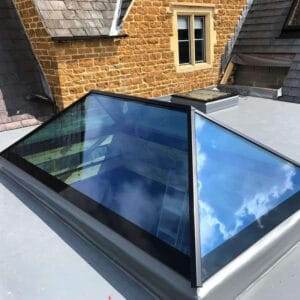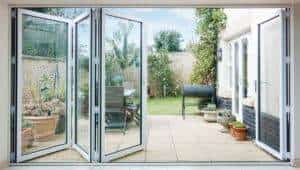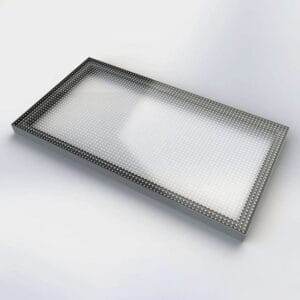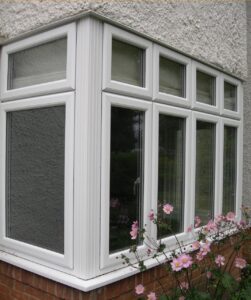Perplexed by the myriad of window energy ratings? Fear not, for this beginner’s guide will demystify the jargon and equip you with the knowledge needed to make informed decisions when it comes to your windows. Understanding window energy ratings is crucial for homeowners, as it determines the efficiency and sustainability of your windows, impacting both your comfort and energy bills. Whether it’s the U-value, solar heat gain coefficient (SHGC), or visible transmittance, this guide will walk you through the key factors to consider when selecting energy-efficient windows. To complement this guide, it’s worth exploring resources such as Energy Star Window Ratings, which provides valuable insights and standards in the industry. By the end of this article, you’ll be equipped with the knowledge to confidently navigate the world of window energy ratings.
Key Takeaways:
- Understanding Window Energy Ratings: Window energy ratings measure the efficiency of a window in terms of heat loss, solar gain, and air leakage.
- Choosing the Right Rating: Higher window energy ratings indicate better insulation and energy efficiency, so it’s important to consider these ratings when selecting windows for your home.
- Factors Contributing to Ratings: Window frame material, glazing type, and installation all play a significant role in determining the energy rating of a window.
- Impact on Energy Bills: Windows with higher energy ratings can help reduce heating and cooling costs by minimising heat loss and maximising solar gain.
- Environmental Benefits: Opting for windows with higher energy ratings not only saves money, but also helps reduce the carbon footprint of a home by consuming less energy for heating and cooling.
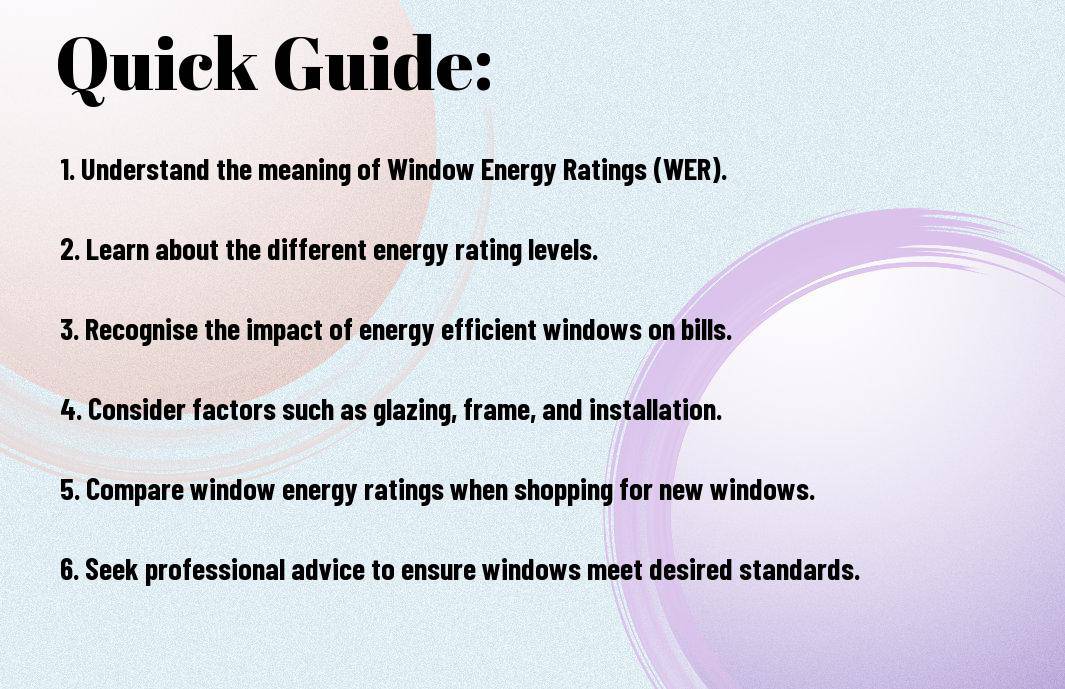
Understanding the Basics
Before delving into the intricacies of window energy ratings, it’s important to grasp the foundational principles behind this concept. Window energy ratings are a measurement of a window’s energy efficiency, providing valuable insight into how well a window prevents heat loss and controls solar gain. Understanding these ratings is crucial for making informed decisions when choosing windows for your property.
Types of Window Energy Ratings
When it comes to window energy ratings, there are primarily two main systems used in the UK: U-Value and WERS (Window Energy Rating Scheme). These ratings are designed to measure different aspects of a window’s performance, with U-Value focusing on heat loss and WERS taking into account a window’s overall energy efficiency. For a comprehensive understanding of a window’s performance, it’s essential to consider both of these ratings. Assume that a window with a low U-Value and a high WERS rating is the most energy-efficient.
| Rating Type | Measurement |
|---|---|
| U-Value | Heat loss |
| WERS | Overall energy efficiency |
| Low U-Value | Reduced heat loss |
| High WERS | High energy efficiency |
Key Factors Influencing Energy Efficiency
Several key factors play a crucial role in determining the energy efficiency of a window. These include glazing type, frame material, multi-chamber profile design, air leakage, and solar heat gain coefficient. Recognising the impact of these factors is essential for evaluating the overall performance of a window and its potential energy savings.
- Glazing type
- Frame material
- Multi-chamber profile design
- Air leakage
- Solar heat gain coefficient
Recognizing the significant role of these key factors in determining a window’s energy efficiency is crucial for making informed decisions when selecting windows for your property. By understanding the impact of glazing type, frame material, multi-chamber profile design, air leakage, and solar heat gain coefficient, you can effectively assess the energy-saving potential of different window options.
Choosing the Right Windows
When it comes to choosing the right windows for your home, understanding window energy ratings is crucial. This helps you make informed decisions that can lead to energy efficiency and cost savings in the long run. In this chapter, we will guide you through the process of selecting windows with the best energy ratings for your specific needs.
Step-by-Step Guide to Assessing Energy Ratings
Assessing energy ratings of windows can be a daunting task for beginners. However, breaking it down into manageable steps can simplify the process. Below is a table that outlines the key factors to consider when assessing the energy ratings of windows:
| Factor | Description |
| U-Value | The rate of heat loss through the window. |
| Solar Heat Gain Coefficient (SHGC) | The amount of solar radiation that enters through the window. |
Once you understand these factors, you will be better equipped to assess the energy ratings of different windows and make an informed choice.
Tips for Interpreting Rating Labels
Interpreting rating labels on windows can be confusing, but with the right knowledge, you can decipher the information to make the best decision. Here are some tips to help you interpret rating labels effectively:
- Look for the Energy Star label for high-efficiency windows.
- Compare U-Values and SHGC ratings to understand the overall energy performance of the window.
- Consider the climate zone of your location when interpreting ratings.
Perceiving the significance of these tips will empower you to choose windows with superior energy performance.
For more detailed information on interpreting rating labels, consider consulting with a professional window supplier to ensure you make the best decision for your home.
Maximising Energy Efficiency
When it comes to maximising energy efficiency in your home, the windows play a critical role. Choosing the right window energy ratings and ensuring proper installation and maintenance are key factors in achieving optimal energy efficiency.
Factors to Consider in Window Installation
When installing window energy ratings, it is important to consider factors such as type of window frame material, proper sealing and insulation, and orientation of the windows. Ensuring that the windows are installed correctly and in the right location can significantly impact the overall energy efficiency of your home. Perceiving potential issues and addressing them during installation can prevent energy loss and improve the performance of your windows.
Pros and Cons of Different Window Technologies
There are various window technologies available in the market, each with its own set of pros and cons. It’s essential to weigh the benefits and drawbacks of each technology before making a decision. Below is a breakdown of the pros and cons of some popular window technologies in a detailed table:
| Window Technology | Pros and Cons |
|---|---|
| Double Glazing | Pros: Improved insulation, reduced energy bills. Cons: Potential for condensation, higher initial cost. |
| Triple Glazing | Pros: Enhanced thermal performance, sound insulation. Cons: Higher cost, added weight. |
| Low-E Glass | Pros: Blocks UV radiation, reduces heat transfer. Cons: Higher upfront cost, potential discolouration. |
It’s important to carefully evaluate the pros and cons of different window technologies to make an informed decision that suits your specific requirements. Factors such as climate, budget, and long-term performance should be taken into consideration when choosing the right window technology for your home.

Saving Money and Energy
Understanding window energy ratings is essential for Understanding Window Efficiency, as it can help you make informed decisions that can save you money and energy in the long run. By choosing windows with high energy ratings, you can significantly reduce your energy bills and create a more comfortable living environment.
Long-Term Benefits of Energy-Efficient Windows
Investing in energy-efficient windows offers numerous long-term benefits. Not only do they contribute to lower energy bills by reducing heat loss and heat gain, but they also improve the overall comfort of your home. Additionally, energy-efficient windows can enhance the resale value of your property, making them a wise investment in the long term.
Moreover, high-performance windows can also contribute to a quieter and more peaceful indoor environment by reducing external noise. This can have a positive impact on your overall wellbeing and quality of life.
Tips for Maintenance and Upgrades
Regular maintenance and occasional upgrades are crucial for ensuring that your windows continue to perform at their best. Start by sealing any gaps or cracks around the window frames to prevent drafts and improve energy efficiency. Consider upgrading to double or triple-glazed windows to further enhance energy performance and thermal insulation.
- Regularly clean and inspect your windows to identify any issues early on.
- Repair any damaged seals or weather stripping to maintain optimal insulation.
- Consider installing window treatments such as blinds or curtains to enhance energy efficiency.
Any upgrades or maintenance tasks should be carried out by a professional to ensure that they are done correctly and safely. Additionally, don’t overlook the importance of proper ventilation and airtight seals to maximise energy efficiency.
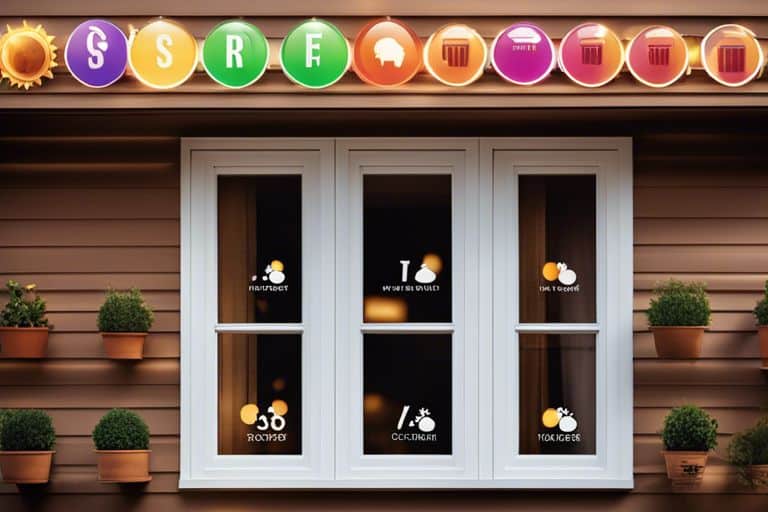
A Beginner’s Guide to Understanding Window Energy Ratings
Understanding window energy ratings is crucial for anyone looking to make their home more energy-efficient. This guide has provided a comprehensive overview of the different ratings and what they mean in terms of a window’s performance. By now, you should have a better understanding of U-values, solar heat gain coefficients, and other measures used to assess a window’s energy efficiency. For further information on how to choose energy-efficient windows, you can refer to this informative article: Explained: Energy Star Ratings for Windows. Energy-efficient windows can not only save you money on your energy bills but also reduce your home’s carbon footprint. It’s important to make informed decisions when it comes to upgrading your windows, and understanding energy ratings is the first step towards making the right choices for your home.
FAQ
Q: What is a Window Energy Rating (WER)?
A: The Window Energy Rating (WER) is a standardised measurement that assesses the energy efficiency of windows, taking into account factors such as heat loss, solar gain, and air leakage.
Q: How is the WER calculated?
A: The WER is calculated using a formula that considers the thermal transmittance (U-value), solar factor (g-value), and air leakage of the window. These factors are then combined to produce a rating on a scale from A++ to G.
Q: What are the benefits of choosing windows with a higher WER?
A: Windows with a higher WER can significantly reduce energy bills, improve thermal comfort, and contribute to a more sustainable and environmentally friendly home.
Q: What do the different WER ratings mean?
A: A++ is the highest rating and indicates the most energy-efficient windows, while G is the lowest rating and signifies the least efficient windows. Choosing a higher rated window can lead to greater energy savings and comfort.
Q: How can I improve the energy efficiency of my windows?
A: To improve the energy efficiency of your windows, you can consider factors such as frame material, glazing options, and installation techniques. Upgrading to windows with a higher WER is also a sure way to enhance energy efficiency in your home.

